NATIONAL GEOGRAPHIC, OCTOBER 1915
How come 1,500,000 Armenians had been killed in the so called genocide?

POSTERS OF ARMENIAN GENOCIDE LIE
http://genoposts.blogspot.com/
IS UNIVERSITY OF MINNESOTA AWARE OF MATHEMATICS?
There is a comparative table published in the history section of University of Minnesota’s web portal in relation to the so called Armenian Genocide about the population of Ottoman Armenians between 1914 & 1922. This table compares Ottoman Armenians living in Ottoman Empire in 1914 and in 1922. The first conclusion a person can arrive at by looking at this table, assuming that he or she uses this table as a reference point, is that Ottoman Armenians around 1.750.000 had been kiled between the years of 1914 & 1922.
The first question that comes to mind is whether this table was prepared by an academical institution or not and if so how many official or unofficial annexes referring to those years were used in the preparation of the table since there are no references given for the table. However the prime question indeed is why 1922 is mentioned and not 1919 or

To answer this question I need to share with you some of the official documents from US, British, Armenian and League of Nations archives. First of all let’s look at the population of Ottoman Armenians in North Syria in year 1916, the place that forms the basis of the ‘genocide’ claims where
supposedly Ottoman Armenians had been killed after exiled to.
The number of Ottoman Armenians present in year 1916 in North Syria after the exile had been quoted as 486,000 in the official letter sent to American Ambassador of Istanbul, Henry Morgenthau by American Consul of Aleppo.
The letter also mentions that this number had been verified by the Armenian Patriarch Vahran Tahmizian. This number of 486.000 is qouted only for the Ottoman Armenians exiled to North Syria and the letter continues to mention about the aid and care provided by the American charities to the Armenians in the region
Click to Link for Document
(US Archives State Department Record Group 59, from 867.48/271, Ara Sarafyan, United States Official Documents on the Armenian Genocide, Vol II, s. 112-113).
The prime official document proving the number of Ottoman Armenians living in the Empire after WW1 is another one from US archives though. This official American document qoutes the number of Ottoman Armenians living in the Empire after WW1 as 624,000 which is also confirmed by Armenian Patriarch Vartan Amirhanian
(US. Archives Nara, T1192 R2. 860J.01/395).
Page 1
Page 2
Page 3
Page 4
Please keep the numbers in mind (624.000). By the way, Ottoman Armenians started to emigrate to Caucasus with the inception of WW1 in 1914. Although Ottoman Empire decided to relocate Armenians in above mentioned locations, Batumi Ambassador of Britain P. Stevens indicated that many Armenians were not even subject to obligatory relocation and were taken away by Russians to Caucasus in the report he sent to London on 25th Feb, 1916.
[Halaçoğlu, Armenians: Exile and Migration,p.84-85]
This is also confirmed in the report of British Lord Major Found which he wrote about 1915. 250.000 Armenians moved to Caucasus Armenia from Anatolia fighting against illnesses and war conditions.
[U.K.FO 96/205]
250.000 figure was confirmed in the report sent by Armenian National Delegation Chairman Boghos Nubar to Ministry of Foreign Affairs of France in addition to the figure of 40.000 Ottoman Armenians being in Iran.
Archives des Afferes Etrangeres de France,
Serie Levant, Armenie, Vol. 2, folio 47-1918

According to an offical American document published in 1919, the number of Ottoman Armenians migrated to Caucasus had reached to 300,000.
[The Republic Of Armenia–A Memorandum , On The Recognition Of The Government Of The Republic Of Armenia, Submitted By The Special Mission Of The Republic Of Armenia To The United States– Presented By Mr. Lodge,November 10,1919, Washington,Government Printing Office 1919]
The number of Ottoman Armenians migrated to South Russia is qouted as 70,000 within the same document.
The number of Ottoman Armenians migrated to Armenian of Caucasus had been indicated precisely as 400,000 by the Refugees High Commissioner Fridjof Nansen of League of Nations
(8th meeting of League of Nations 19th October, 1928).
November 1919 issue of National Geographic mentions of a 20,000 Ottoman Armenians residing in Tbilisi (Georgia).
Now let’s add all these number together.
624,000 in Ottoman Empire (American National Archives)
400,000 in Armenia of Caucasus (Fridjof Nansen-League of Nations)
70,000 in South Russia (Mr. Lodge Washington Government Printing Office)
40,000 in Iran (BoghosNubar-Archives des Afferes Etrangeres de France)
20,000 in Georgia (National Geographic 1919 Nov. Issue)
1,154,000 TOTAL
Without even questioning or examining the validity of the references of University of Minnesota, qouting the population of Ottoman Armenians as 2,133,190 in 1914, we conclude that 1,154,000 Ottoman Armenians were alive in 1921.
Anyone with a sane mind asks the same questions at this stage:
How come 1,500,000 Armenians had been killed in the so called genocide?
Does the University of Minnesota know mathematics?
I have two suggestions for the University of Minnesota:
1.They either prove the documents shown in this paper to be fake to avoid the powerless or weak position that many academical institutions have to go through because of their need for donations from different loby groups or,
2.They start taking calculus courses.
The mathematical conclusion we arrive at is that ‘History’ is not a discipline that can be used as a political exploitation tool as people see fit.
—————————————————————————————————————————————————
Halacoglu Is Responding to Taner Akcam
 |
TARAF 29th of May,2008
[Click for Turkish]
Yusuf Halacoglu Responding
Dikran M. KHALIGIAN from Armenian National Committee indicated in a documentary filmed in 2003 that the archives of Dashnak Sutyun were being prepared to be opened and that Dashnak Sutyun was in the process of presenting the archives to 3rd parties. He also indicated that the access to the archives was limited up until that time and permits were required to have access to them. He explained the reason for this limited access by indicating that the documents were very old and valuable and that some precautions had to be taken to preserve them before they were public use.
‘I am sending this response in relation to the accusations and claims directed against me as well as the questions asked in the article printed in Taraf newspaper on 25.05.2008 under the name of ‘Forget about the Armenian Archives, look at your own Ottoman Archives’. I would like the response to be printed with the same page and font formats if possible.’
I have been receiving positive feedback from different regions about my offer of giving USD 20 million to Armenians in return for access to their archives. This offer was published in Hürriyet newspaper on 20th of May, 2008 as a headline news. If we are to investigate events of 1915 on a proper basis, then Dashnak and Armenia archives as well as other Armenian archives in Jerusalem should be opened and investigated. Third party archives are as important as these aforementioned archives with regards to this matter though. Up until now we have seen pressure only on Ottoman Archives to be opened but not on any other archives. Then why has noone spoken of also opening Armenian archives as they represent the other side of the story? In a historical investigation, anyone very well knows that all related documents should be checked and analyzed in order to investigate objectively all sides of the story. At this stage, Ms. Hür questions what use Dashnak archives are to me. Whatever you are hoping to find from Ottoman archives yourself is applicable to the same extent to Dashnak archives, I am hopeful that I can reach very valuable information in these archives and Dashnak papers and documents in Russian archives presently support my position. Meanwhile, Ms. Hür is talking about the inappropriateness of my offer. I had difficulty in understanding why my offer was inappropriate. Why is offering financial support for the classification of these archives inappropriate? I think she has her own reasons for not supporting the idea of opening of these archives. I do not know about that, however if we are to contact with our Armenian colleagues and other Armenians on the subject matter, it is vital for all archives to be opened without hesitation to the service of all researchers from all around the world. Anyone should be able to confront history without fear. On the other hand, despite the disclaimer of Diaspora indicating that the archives in Boston are open to everyone, many people and foremost Ara Sarafyan indicate that the archives are open only for limited use by specific people.
Also in a documentary filmed by TRT in 2003, consulted by Prof. Dr. Kemal Çiçek from our institution, Dikran M. KHALIGIAN himself from Armenian National Committee indicated that the archives of Dashnak Sutyun were being prepared to be opened and that Dashnak Sutyun was in the process of presenting the archives to 3rd parties. He also indicated that the access to the archives was limited up until that time and permits were required to have access to them. He explained the reason for this limited access by indicating that the documents were very old and valuable and that some precautions had to be taken to preserve them before they were public use. So he gave the signal of the archives to be opened in a very short period of time. In the same documentary Mr. KHALIGIAN also indicated that there was need of a considerable amount of financial support for the classification of the archives. As you can see from this, noone other than Armenians or a few people supporting their thesis could make any research on the archives. You can not conclude that the archives are open by just the investigation and analysis of five researchers on the archives. Also in order for us to talk about archives being open for public use, it means that all papers and documents of the archives should be open. However it was announced that only four volumes of these archives were open. Let alone these volumes not having been presented to the whole science world, we do not know whether they include selective documentation. Despite all this, Ms. Hür supports Taner Akçam passionately by claiming that Ottoman Archives are closed or selectively presented and meanwhile she can not help but admit that she also benefited from Ottoman archives.
The claim of the Ottoman archives being sorted out and selectively presented creates a funny and ridiculous position today. If so, why did not the British claim such a thing during occupation of İstanbul, especially in a time when they were desperately after finding evidence to trial Malta deportees? Can these claims be just second guesses or predictions? We should not rule out other reasons if we consider that the newspapers back then had got financial support from various countries. Also Ottoman correspondence language and bureaucracy should be very well known in order to be able to understand whether Ottoman archives were sorted out . To know these things very well requires a considerable amount of time being devoted for investigation of Ottoman archives. People devoting such time to investigate Ottoman archives very well know that letters sent from central administration had been sent to many places and even if the ones kept by the central administration had been destroyed, this case is not applicable to the ones kept by local authorities. As a matter of fact, Prof. Dr. Selim Deringil indicated in a dialogue with Mr. Safa Kaplan which was printed in Hürriyet newspaper on 25th of April, 2005 that the Ottoman archives could not have been possibly sorted out. Same thing was indicated by Prof. Dr. Şükrü Hanioğlu. It is also quite a show of prejudice to indicate that it is almost impossible to investigate ATASE Archive. I suggest she makes a formal application to request such investigation.
Ms. Hür is claiming that even after the Ottoman archives were sorted out(!), what is left in the archives are alone enough proof for the so called genocide by basing her claims on Taner Akçam’s book called ‘Armenian Issue is Resolved’. However when the documents used in the book are compared with the originals of those documents, it will be clearly seen that the claims of Mr. Akçam are baseless. The two examples that I will be giving are perfect proof of how these documents had been distorted. The first example is related to a telegraph registered under DH. ŞFR. # 55/290 and where Mr. Akçam took the name of his book from. Mr. Akçam is trying to condition the reader that all Armenians had been killed by selectively referring to a sentence in the telegraph. The sentence in the telegraph is as follows: ‘The Armenian issue in the eastern provinces has been resolved’ (p. 182). However Mr. Akçam is just taking some part of the sentence and he is stating that ‘Armenian issue is resolved’. The reason why he is cherry picking some part of the sentence is because he is trying to prove that all Armenians in the country at the time had been attacked and had been victims of a genocide. Also he did not make any reference to other parts of the telegraph in his book where indeed the real striking sentences were included and he did not mention in his book why this telegraph had been written in the first place. When we investigate the telegraph with the dignity of a scholar, we see that some Armenians around Ankara were raped by some officers in charge of the relocation, gendarme or by public and rapers were also committing theft to satisfy their lower selves. The telegraph continues to indicate the sorrow the Ottoman Ministry was feeling because of these incidents. This means that let alone murdering or massacring Armenians, Ottoman authorities were very upset because of these incidents and orders were issued indicating that necessary precautions should be taken to prevent these types of incidents in the future. As a matter of fact, 146 people who were said to get involved in these incidents were instigated to military court.
The second example is the reference made to the key telegraph dated 29th of June, 1331 (12th of July, 1915 according to gregorian calender) which was sent by Talat Pasha to the province of Diyarbakır (DH., ŞFR. Nr.54/406). The specific reference was made to the 185th page of the telegraph, where the issue in relation to Diyarbakır and Dr. Reşid was mentioned. Mr. Akçam here again fails to include the most important parts of the telegraph. He interpretes some sentences on the aforementioned page of the telegraph as some Armenians in the province as well as some other Christians from differing sects were being murdered lately and that some people sent from Diyarbakır butchered a total of 700 Christians, Armenians and other including reverends, in the city of Mardin by taking them out of the city. However he fails to include the said sentences in full in his book where he leaves certain parts out which results in misinterpretation of the meanings of the sentences. I included the full version of these sentences in my book called ‘Facts on the Relocation of Armenians’ ( I also included a copy of the telegraph in question at the end of my book). Mr. Akçam, when making reference to the said sentences in Ottoman Turkish on page 185 of the telegraph, fails to include two words (‘ez-cümle ahiren’ / ‘according to this sentence afterwards’) that are indeed on the original sentence, thereby changing the meaning of the sentences totally. He interprets that people sent from Diyarbakır were sent to butcher Armenians and other Christians, however when you continue to read the rest of the sentences you see that the people sent from Diyarbakır were sent to investigate the alleged murders of Armenians and other Christians in the province. Mr. Akçam also misspells the word ‘marhasa’ which means Armenian reverend in Ottoman Turkish by writing it as ‘murahhas’ which means officer or member in Ottoman Turkish. He does this with the intention of trying to get some government officers involved in the matter indeed when the matter did not have anything to do with government officers. In summary, people sent from Diyarbakır were sent to investigate the allegations by consulting Armenian reverends, Armenian public and other Christians in the city. A thorough critique of the book is being prepared by our institution.
Dikran M. KHALIGIAN from Armenian National Committee indicated in a documentary filmed in 2003 that the archives of Dashnak Sutyun were being prepared to be opened and that Dashnak Sutyun was in the process of presenting the archives to 3rd parties. He also indicated that the access to the archives was limited up until that time and permits were required to have access to them. He explained the reason for this limited access by indicating that the documents were very old and valuable and that some precautions had to be taken to preserve them before they were public use.
‘I am sending this response in relation to the accusations and claims directed against me as well as the questions asked in the article printed in Taraf newspaper on 25.05.2008 under the name of ‘Forget about the Armenian Archives, look at your own Ottoman Archives’. I would like the response to be printed with the same page and font formats if possible.’
I have been receiving positive feedback from different regions about my offer of giving USD 20 million to Armenians in return for access to their archives. This offer was published in Hürriyet newspaper on 20th of May, 2008 as a headline news. If we are to investigate events of 1915 on a proper basis, then Dashnak and Armenia archives as well as other Armenian archives in Jerusalem should be opened and investigated. Third party archives are as important as these aforementioned archives with regards to this matter though. Up until now we have seen pressure only on Ottoman Archives to be opened but not on any other archives. Then why has noone spoken of also opening Armenian archives as they represent the other side of the story? In a historical investigation, anyone very well knows that all related documents should be checked and analyzed in order to investigate objectively all sides of the story. At this stage, Ms. Hür questions what use Dashnak archives are to me. Whatever you are hoping to find from Ottoman archives yourself is applicable to the same extent to Dashnak archives, I am hopeful that I can reach very valuable information in these archives and Dashnak papers and documents in Russian archives presently support my position. Meanwhile, Ms. Hür is talking about the inappropriateness of my offer. I had difficulty in understanding why my offer was inappropriate. Why is offering financial support for the classification of these archives inappropriate? I think she has her own reasons for not supporting the idea of opening of these archives. I do not know about that, however if we are to contact with our Armenian colleagues and other Armenians on the subject matter, it is vital for all archives to be opened without hesitation to the service of all researchers from all around the world. Anyone should be able to confront history without fear. On the other hand, despite the disclaimer of Diaspora indicating that the archives in Boston are open to everyone, many people and foremost Ara Sarafyan indicate that the archives are open only for limited use by specific people.
Also in a documentary filmed by TRT in 2003, consulted by Prof. Dr. Kemal Çiçek from our institution, Dikran M. KHALIGIAN himself from Armenian National Committee indicated that the archives of Dashnak Sutyun were being prepared to be opened and that Dashnak Sutyun was in the process of presenting the archives to 3rd parties. He also indicated that the access to the archives was limited up until that time and permits were required to have access to them. He explained the reason for this limited access by indicating that the documents were very old and valuable and that some precautions had to be taken to preserve them before they were public use. So he gave the signal of the archives to be opened in a very short period of time. In the same documentary Mr. KHALIGIAN also indicated that there was need of a considerable amount of financial support for the classification of the archives. As you can see from this, noone other than Armenians or a few people supporting their thesis could make any research on the archives. You can not conclude that the archives are open by just the investigation and analysis of five researchers on the archives. Also in order for us to talk about archives being open for public use, it means that all papers and documents of the archives should be open. However it was announced that only four volumes of these archives were open. Let alone these volumes not having been presented to the whole science world, we do not know whether they include selective documentation. Despite all this, Ms. Hür supports Taner Akçam passionately by claiming that Ottoman Archives are closed or selectively presented and meanwhile she can not help but admit that she also benefited from Ottoman archives.
The claim of the Ottoman archives being sorted out and selectively presented creates a funny and ridiculous position today. If so, why did not the British claim such a thing during occupation of İstanbul, especially in a time when they were desperately after finding evidence to trial Malta deportees? Can these claims be just second guesses or predictions? We should not rule out other reasons if we consider that the newspapers back then had got financial support from various countries. Also Ottoman correspondence language and bureaucracy should be very well known in order to be able to understand whether Ottoman archives were sorted out . To know these things very well requires a considerable amount of time being devoted for investigation of Ottoman archives. People devoting such time to investigate Ottoman archives very well know that letters sent from central administration had been sent to many places and even if the ones kept by the central administration had been destroyed, this case is not applicable to the ones kept by local authorities. As a matter of fact, Prof. Dr. Selim Deringil indicated in a dialogue with Mr. Safa Kaplan which was printed in Hürriyet newspaper on 25th of April, 2005 that the Ottoman archives could not have been possibly sorted out. Same thing was indicated by Prof. Dr. Şükrü Hanioğlu. It is also quite a show of prejudice to indicate that it is almost impossible to investigate ATASE Archive. I suggest she makes a formal application to request such investigation.
Ms. Hür is claiming that even after the Ottoman archives were sorted out(!), what is left in the archives are alone enough proof for the so called genocide by basing her claims on Taner Akçam’s book called ‘Armenian Issue is Resolved’. However when the documents used in the book are compared with the originals of those documents, it will be clearly seen that the claims of Mr. Akçam are baseless. The two examples that I will be giving are perfect proof of how these documents had been distorted. The first example is related to a telegraph registered under DH. ŞFR. # 55/290 and where Mr. Akçam took the name of his book from. Mr. Akçam is trying to condition the reader that all Armenians had been killed by selectively referring to a sentence in the telegraph. The sentence in the telegraph is as follows: ‘The Armenian issue in the eastern provinces has been resolved’ (p. 182). However Mr. Akçam is just taking some part of the sentence and he is stating that ‘Armenian issue is resolved’. The reason why he is cherry picking some part of the sentence is because he is trying to prove that all Armenians in the country at the time had been attacked and had been victims of a genocide. Also he did not make any reference to other parts of the telegraph in his book where indeed the real striking sentences were included and he did not mention in his book why this telegraph had been written in the first place. When we investigate the telegraph with the dignity of a scholar, we see that some Armenians around Ankara were raped by some officers in charge of the relocation, gendarme or by public and rapers were also committing theft to satisfy their lower selves. The telegraph continues to indicate the sorrow the Ottoman Ministry was feeling because of these incidents. This means that let alone murdering or massacring Armenians, Ottoman authorities were very upset because of these incidents and orders were issued indicating that necessary precautions should be taken to prevent these types of incidents in the future. As a matter of fact, 146 people who were said to get involved in these incidents were instigated to martial court.
The second example is the reference made to the key telegraph dated 29th of June, 1331 (12th of July, 1915 according to gregorian calender) which was sent by Talat Pasha to the province of Diyarbakır (DH., ŞFR. Nr.54/406). The specific reference was made to the 185th page of the telegraph, where the issue in relation to Diyarbakır and Dr. Reşid was mentioned. Mr. Akçam here again fails to include the most important parts of the telegraph. He interpretes some sentences on the aforementioned page of the telegraph as some Armenians in the province as well as some other Christians from differing sects were being murdered lately and that some people sent from Diyarbakır butchered a total of 700 Christians, Armenians and other including reverends, in the city of Mardin by taking them out of the city. However he fails to include the said sentences in full in his book where he leaves certain parts out which results in misinterpretation of the meanings of the sentences. I included the full version of these sentences in my book called ‘Facts on the Relocation of Armenians’ ( I also included a copy of the telegraph in question at the end of my book). Mr. Akçam, when making reference to the said sentences in Ottoman Turkish on page 185 of the telegraph, fails to include two words (‘ez-cümle ahiren’ / ‘according to this sentence afterwards’) that are indeed on the original sentence, thereby changing the meaning of the sentences totally. He interprets that people sent from Diyarbakır were sent to butcher Armenians and other Christians, however when you continue to read the rest of the sentences you see that the people sent from Diyarbakır were sent to investigate the alleged murders of Armenians and other Christians in the province. Mr. Akçam also misspells the word ‘marhasa’ which means Armenian reverend in Ottoman Turkish by writing it as ‘murahhas’ which means officer or member in Ottoman Turkish. He does this with the intention of trying to get some government officers involved in the matter indeed when the matter did not have anything to do with government officers. In summary, people sent from Diyarbakır were sent to investigate the allegations by consulting Armenian reverends, Armenian public and other Christians in the city. A thorough critique of the book is being prepared by our institution.
Meanwhile, Andonian papers that were qouted as highly reliable evidences, were proven to be fake by the book called ‘The Real Story Behind the Telegraphs that were Attributed to Talat Pasha by Armenians’ written by Şinasi Orel and Süreyya Yüce (Ermenilerce Talat Paşa’ya Atfedilen Telgrafların Gerçek Yüzü – Ankara 1976). Andonian family immigrated to USA in 1923. You can find their ‘immigration document’ in Appendix 1. You can also find two examples of the telegraphs that are supposed to have been written by Talat Pasha in Appendix 2. However it can easily be understood with even simple eyes that these telegraphs have nothing to do with Ottoman telegraphs, that they are full of errors and that they had been written post events.
I would also like to comment on some of the criticisms of Taner Akçam in relation to some of the issues that were included in my book called ‘Facts on the Relocation of Armenians’. First of all, I published a book to respond to questions and criticims of Taner Akçam. If Ms. Hür reads my book called ‘From Exile to Genocide: A Turk examines the Armenian claims against his country’ (Babıali Kültür Publishing, İstanbul, 5th edition, February 2008, 1st edition by February 2006), she will see clearly that all points and questions of Taner Akçam were answered by related documents. As a matter of fact, it was included in the book that the villains attacking the Armenian convoys being transferred to Syria in 1915, killing people, seizuring their possessions and / or kidnapping women from the convoys were sent to martial court for trial by the order given by Talat Pasha’s himself. 67 of the judged were sentenced to death, 68 were punished by forced labor and / or confined to fortresses and 524 were sentenced to imprisonment for periods between 2 to 5 years with the rulings of the martial court given on 19th of Feb, 12th of March and 22nd of May, 1916. The death sentences were executed and the information and documents related to these were already included in the book. The book also includes a list of how many people from which cities were instigated to courts. To confirm all these, a page of the ruling of the martial court is included in Appendix 3. In this document, it is seen that let alone for killing Armenians, criminals had been sentenced to death for even seizuring Armenians’ possessions. I believe these documents are perfect answers to ‘Akçam is questioning, Halaçoğlu is remaining silent’. Indeed, we gave all necessary answers long before but I guess they did not have the time to read my book for that. The books includes information as to the sources sent from Eskişehir in relation to the ‘Abandoned Property Commissions’ of ‘200,000 kuruş’ and ‘600,000 kuruş’. It should be assessed cautiously why these people who considered the application of these abandoned property commissions not as a government in war trying to preserve the lives of its citizens at all costs but as the government taking possession of Armenian goods and property, were at the same totally ignoring the ‘68 million kuruş’ approved and sent from government budget to Ministry of Internal Affairs for the proper relocation and settlement of Armenians and ’13,467,400 kuruş’ which was sent to Ministry of Health for the same reasons. The cash sent to provinces during the same period totalled ‘3,166,900’. ‘800,000 kuruş’ out of this was from abandoned property commissions. Whom was this amount sent for? This question is answered by the report sent by the then Aleppo consul of US, J.B. Jackson on 8th of Feb, 1916 to Ambassador Henry Morgenthau stating that 500,000 Armenian immigrants had arrived at Aleppo and 486,000 out of this were provided ncecssary care and aid (a photocopy of the report is included in the book). Jackson also included the cities and villages where the immigrant Armenians had been located in his report. The book also includes documents and their numbers which pertain to permits given by Talat Pasha to foreign charities in relation to the aids to be provided to Armenians in need. They also ignore the fact that Ottoman government allocated daily wages to Armenian migrants of ‘3 kuruş’ for the adults and ’60 para’ for the children, just for the sake of trying to prove a so-called genocide. We see that this allocation was also mentioned in the letter sent to Ambassador Morgenthau by Dr. W. M. Post working in an American hospital in Konya, as ‘1 kuruş’ to adults and ’20 para’ to children.
Meanwhile people who are making such claims, first and foremost Ms. Hür, should be well aware of the meaning of the word ‘genocide’. They should be well aware that seizure of Armenian possessions or exiling Armenians do not constitute a genocide. They should be well aware that by claiming that Ottoman archives had been sorted out or cherry picked, they can not prove a genocide. And of course they should also be well aware that the mere fact of some Armenians losing their lives do not constitute a genocide. Can the documents in the ‘League of Nations’ archives in Geneva proving that 1,200,000 Armenians were living after WW1 (the ones living under different identities are excluded) or the letter sent by Boghos Nubar Pasha, the chairman of Armenian National Delegation, to French Minister of External Affairs stating that they fought alongside with Entente Powers and that they lost many Ottoman Armenian soldiers fighting in French, English and Russian armies be ignored? How are the riots and uprisings of Armenians back then that were also mentioned in French and Russian archives going to be explained? And unfortunately it should also be assessed carefully why these ‘informal’ historians are not responding positively to the request of us, we the ‘formal’ historians, whereby we request to be able to openly discuss the issues with all historians whether Turkish or not or we request to be able to make researches together. But most importantly, they need to be able to answer our questions as listed below:
1. Had Armenians rioted before and after WW1?
2. Had Armenians cooperated with western powers military and administrative wise?
3. Had they fought against Ottomans in Russian, English and French armies?
4. Do you know the activities of Nazarbekov and Andranik in 1914 & 1915?
5. How many Muslim civilians had been massacred by Armenian comittees until the period of ‘Relocation’ which is up to the date of 27th of May, 1915?
6. Who surrendered Van to Russians and who burnt down and destroyed the city?
7. How many Armenians had survived WW1?
8. How many Armenian riots and uprisings had taken place between November 1914 and May 1915 when Ottoman empire had been fighting in 4 different battles?
9. Which countries had provided arms to Armenian Committees?
10. Do you know anything about the Armenians who had sacrificed their lives for France?
11. What are the reasons for Ottoman administration and people to feel hatred and hositility against Armenians?
(29th of May,2008)
Fake Illustrations Used In Armenian Genocide Allegations
(Ermeniler, sözde soykırım iddialarını desteklemek için birçok resmi olmayan sitede çok sayıda sahte resim kullanmakta ve bu sayede sadece gerçekleri çarpıtmakla kalmayıp haksız davalarına duygu sömürüsü yoluyla katılımı arttırmaktadırlar.)
Fake Picture No:1
A woman who had been slaughtered by Turks ?
PhotoLink1
PhotoLink2
This picture indeed belongs to a Jewish woman slaughtered by Nazi Arrow Cross Men Party during WW2 in Hungary. This is an official historical evidence of Holocaust but Armenians nonetheless use this picture to deceive people and show it as an Armenian woman slaughtered by Turks with a shameful act.
(Bu fotoğraf , İkinci Dünya Savaşı’nda Macaristan’da Nazi Arrow Cross Men Partisi tarafından katledilen Jahudi kadına aittir.
Holocaust’un tarihi belgesi olarak kayıtlara girmiştir.Ermeniler tarafından utanmasızca ”Türklerin katlettiği Ermeni Kadın”
olarak gösterilmektedir..)
Fake Picture No: 2
Heads decapitated by Turks ?
This picture indeed belongs to White Rose activitists who fought against Nazis in Germany during WW2. These activists were sentenced to death and then killed via guillotine by Nazi Germany.
(Bu fotoğraf İkinici Dünya Savaşı esnasında Almanya’da Nazilere Karşı savaşan White Rose hareketi üyelerine aittir. Nazi Almanyası tarafından giyotinle Başları kesilerek idam edilmişlerdir.)
Fake Picture No: 3
Armenian women and children slaughtered by Turks ?
These women and children in the picture are indeed Turkish women and children slaughtered by Armenians in Subatan (in Ottoman Empire) on 25 April 1918. The picture is being copied by Armenians in internet and is presented as a picture of Armenian victims.

[Original photo is in Turkish Atase Archive]
(Bu fotoğrafta gösterilen kadın ve çocuklar , 25 Nisan 1918 de Türkiye Subatan’da Ermeniler tarafından katledilmiş Türk çocuklarıdır. Bu fotoğrafın orjinali Türk arşivlerindedir. Ermeniler tarafından internet üzerinden kopyalanarak ”Ermeni Kurbanlar” gibi gösterilmektedir.)
Fake Picture No: 4
Women and children slaughtered by Turks ?
These women and children in the picture are indeed Turkish women and children slaughtered by Armenians in Erzincan Vagarir (in Ottoman Empire) on 16 February 1918. The original copy of the picture is in Turkish archives.

(Bu fotoğraf , 16 Şubat 1918’de Turkiye Erzincan’da Vagarir ilçesinde Ermeniler tarafından katledilen Türklere aittir. Bu fotoğrafın orjinali Türk arşivlerindedir.)
Fake Picture No: 5
Armenians slaughtered by Ottoman soldiers
The uniforms of the soldiers in the pic belong to Russian soldiers fighting in Russian Civil War after WW1 and not to Ottoman soldiers. This pic is not related to either Ottomans or Armenians.

(Bu fotoğrafta gösterilen askerlerin üniformaları osmanlı askerlerine değil, 1. Dünya Savaşı sonrası Rus İç savaşındaki Rus askerlerine aittir. Bu fotoğrafın ne Türklerle ne de Ermenilerle bir ilişkisi yoktur.)

02 Nisan 2009 Perşembe
Armenian Genocide Ballyhoo Photo Galerie 3
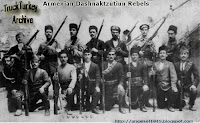
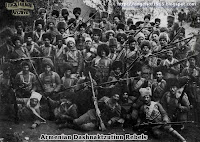

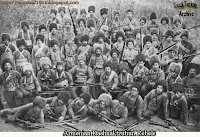

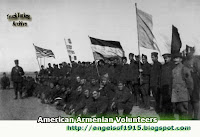




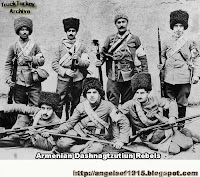



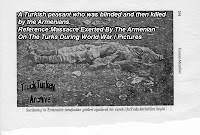
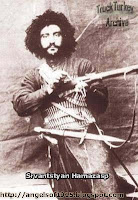
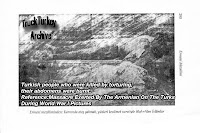

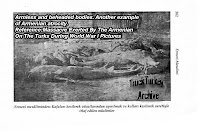


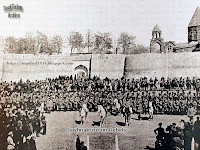
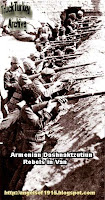
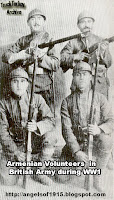
====================================================================================
———————————————————————————————————————————————————-
